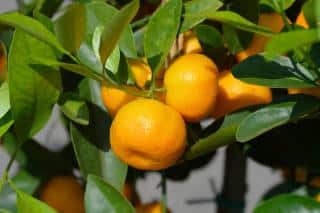

The indoor orange tree is one of the only citrus plants that is perfectly suited to living in the heated indoors of our homes and apartments.
Key Indoor Orange tree facts
Name – Citrus madurensis
Family – Rutaceae (Rue family)
Height – 3 to 6 ½ feet (1 to 2 meters)
Exposure – full sun
Soil – soil mix
Foliage: evergreen – Flowering: January to December
Repotting, care, watering and pruning are all good practices that will help you to grow a very nice calamondin.
Planting potted indoor orange trees
Typical planting of the indoor orange tree is soil mix enriched with fertilizer.
An ideal solution is to pour in a layer of gravel, clay pebbles or rocks to ensure that excess water drains well to the bottom. Make this layer about 1 to 2 inches (3 to 4 cm) thick.
Anticipate re-potting in a pot that is slightly larger than the previous every 2 or 3 years on average.

It isn’t really necessary to prune it.
To rebalance the silhouette or reduce branch size of your indoor orange tree, prune just after repotting, preferably in spring.
You can also provide citrus plant fertilizer during the entire growing phase, from September to January.
Indoors, regularly water with small amounts of water as soon as the soil is dry.
The indoor orange tree is a small fruit shrub that produces edible fruits. Sadly, these are so acidic that they’re not easily taken in. Make jam instead!
If you can, it is good to bring your indoor orange tree out after any risk of freezing has disappeared, from May until the end of summer.
Simply set it in a well-lit spot but avoid direct sunlight during the hottest hours.
Also avoid setting it right next to a radiator in winter because these tend to dry indoor plants up.
Regular adding of citrus plant fertilizer will greatly increase blooming and fruit formation.